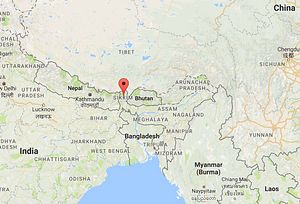After the standoff between China and India at the Doklam plateau ended in an ambiguous but face-saving way, China has been accelerating its cooperation with Nepal, the tiny country that lies between China and India. China’s foreign minister Wang Yi has vowed to elevate China-Nepal cooperative partnership to new heights
On September 7, Krishna Bahadur Mahara, Nepal’s deputy prime minister and minister for foreign affairs, paid an official visit to Beijing and met multiple Chinese high-level officials–including Chinese Premier Li Keqiang, Chinese State Councilor Yang Jiechi, and Wang Yi — in Zhongnanhai, the headquarters of China’s central government.
During Mahara’s visit, all Chinese high officials expressed China’s strong will to strengthen ties with Nepal.
Yang Jiechi said to Mahara that both sides should “seize the general situation of bilateral relations from a strategic height and long-term perspective” and “support each other’s core interests.”
In terms of China’s “core interests,” state sovereignty and territorial integrity have always been two of the most important factors. As in the Doklam stand-off, China repeatedly condemned India for Infringing China’s territory. And from China’s perspective, Nepal did uphold a fair position during the Doklam crisis. As The Diplomat reported, Mahara promised at that time that Nepal would remain neutral in the dispute between China and India, as Nepal would not “get dragged” into both countries’ border dispute.
To show China’s goodwill after Nepal had adhered to neutrality, Li Keqiang said in the latest meeting: “China is ready to provide support within its due capacity to Nepal’s economic and social development.”
Then, Wang Yi elaborated on China’s detailed plan to support Nepal under China’s “Belt and Road” framework:
- To build a cross-border railway between China and Nepal. Although Wang himself didn’t provide details about the railway, previous reports said that the railway, which might cost up to $8 billion, would be 550 kilometer long and connect China’s western Tibet region to Nepal’s capital of Kathmandu, while the funding might mainly provided by China.
- To speed up the repair of two highways, namely the Araniko Highway and the Syabrubensi-Rasuwagadi Highway. These two highways are traditional transit highways connecting China and Nepal, but were severely damaged in the 2015 earthquake.
- To construct three border ports, namely the Zhangmu, Gyirong and Purang port. In particular, Gyirong port will be upgraded to an international port, so that a cross-border economic cooperation zone between China and Nepal could be established.
- To deepen cooperation in the four key areas: trade and investment, post-disaster reconstruction, energy and tourism. Both countries agreed to complete multiple projects and sign multiple memorandums involving the four areas.
At a press conference together with Mahara, Wang Yi said: “We both agreed that the development of China-Nepal relations is conducive to the intrinsic and fundamental interests of the two countries and the two peoples. The two sides will…strive to elevate the friendly and comprehensive cooperative partnership between China and Nepal from generation to generation to new highs.”

































